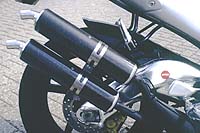First Impression: Aprilia RS250 - Motorcycle.com
Massimiliano "Max" Biaggi rides an Aprilia 250.
He's pretty handy at it too, winning races, winning World Championships, winning everything. He's the best 250cc racer of his generation -- at least he is when he's riding a 250 Aprilia. Now, for the second year, you can buy a replica of Max's bike and dream that the set of bends ahead are in fact the corkscrew at Laguna Seca or the Melbourne loop at Donnington, and if we take this one on the limit we'll have the race in the bag. The Aprilia RS250 takes the wannabe racer on the trip of their lifetime.
A superficial glance at the spec sheet would suggest that Max's GP racer and the RS250 street version are quite closely related. Both run a two-stroke V-twin power plant, although the street bike runs 56mm x 50 mm bore and stroke and the racer a square 54mm x 54mm. In 1994, when Aprilia decided to build a race replica to capitalize on their racing success they turned to the Japanese for the engine, realizing the work involved in building a reliable engine for the street was beyond the means of the small Italian company. Suzuki has been the only one of the Big Four who has continued to support the world market with limited numbers of its own pocket racer, the RGV 250, and it was Suzuki that Aprilia approached for the heart of their new bike. Aprilia builds their own pipes, play around with the ignition some for a better mid-range power delivery and raise the overall compression ratio, but essentially leave the RGV engine unchanged.
It has to be said that the Aprilia RS250 is close to perfect, within the parameters defined for a GP race replica street motorcycle. Its only rivals are the Honda NSR250, Yamaha TZR250, and Suzuki RGV250, which are sold in Japan with an artificially restricted power output of 45 bhp. Only the Suzuki is currently available in other markets, and perhaps the new model, rumored to put out more than 70 bhp, could challenge the Italian machine. Until that time, the Aprilia RS250 will continue unchallenged on both street and track.
Specifications
Manufacturer: Aprilia
Model: 1996 RS250
Price: $10,900
Engine: Liquid-cooled, two stroke V-twin
Bore x stroke: 56 x 50.6 mm
Displacement: 249 cc
Carburetion: Mikuni TM34 SS/2
Transmission: 6-speed
Wheelbase: 1370 mm
Seat Height: 810 mm
Fuel Capacity: 16.5 L
Claimed dry Weight: 141 Kg
Price Comparison:
(Holland)
Aprilia RS 250 - Fl. 17,990 ($10,990)
Honda CBR600F3 - Fl. 22,195 ($13,450)
Suzuki GSXR750 - Fl. 25,999 ($15,750)
More by Colin MacKellar, Dutch Desk
































Comments
Join the conversation